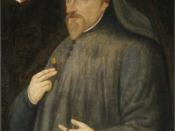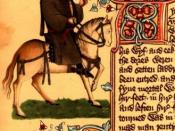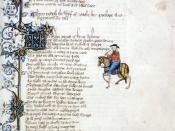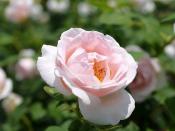Intro: During the Middle Ages, it was very common for Christians to go on pilgrimages to perform what they believed was "Gods work"ÃÂ. "Canterbury Tales"ÃÂ was one of Chaucer's greatest masterpieces', written in the fourteenth-century. It is a collection of stories told by various people who are going on a religious pilgrimage to Canterbury Cathedral from London, England. The characters introduced in the prologue are very unique, and yet manages to embody many physical and behavioral traits that would have been common for someone in their profession. In this time, social class, appearance, manners, education, and motivation for making the pilgrimage was very important and was therefore represented as a difference between ranks of individuals. The following paragraphs will concentrate on the two main female characters of "Canterbury Tales"ÃÂ, the Prioress and the Wyf of Bath.
The Prioress INTRO She is the head of a young ladies' seminary near London, England - She is the highest in social ranking among the women of the seminary.
- She was called "madame Eglentyne"ÃÂ A 1 She had a very modest and quiet smile..
A 2 She wore a delicate wimple (headdress) neatly.
A 3 She had a shapely nose and eyes that were "greye as glas"ÃÂ; she had a soft, small mouth and red lips, and a "fair forheed."ÃÂ A 4 She tries very hard to look elegant and proper, however it is all clearly superficial as she "peyned hir to countrefete chere of court, and been estatlich of manere"ÃÂ.
A 5 Her clothes were "ful fetis"ÃÂ; She wore a coral trinket on her arm, that had a rosary that was colored in green, and a gold broach which said "Amor Vincit Omnia"ÃÂ (Love conquers all), illustrating a nun who was very wealthy and had many valuable possessions.
A 6 Even her beauty is subject to flaw, she is "nat undergrowe"ÃÂ B 1 She is delicate and well-mannered woman.
- wipes her mouth clean - is careful while using a fork - had nothing dripping C Chaucer also states that she is very educated; "And Frensh she spak ful faire and fetishly, after the scole of Stratford atte Bowe, for Frensh of Paris was to hir unknowe"ÃÂ. She speaks school-taught French instead of "Paris style"ÃÂ French, Latin, and English, which means that she can read and write, something not too common, back then.
D Throughout Chaucer's prologue we are presented with a religious person; her portrait defies the basis of her religious order. ÃÂ a server of God ÃÂ purpose: to spread the belief of Christianity around the world CONC Chaucer describes her as a compassionate and tender at heart type of woman who would weep over the death of a small mouse. & dogs also The image we imagine of the Prioress is one of a - modest and genuine - full of life "And sikerly she was of greet disport"ÃÂ - pleasant woman In addition, we picture to have a lofty stature and an insistence on good manners as she is gentle and proper, has excellent people manners, is extremely polite and wasn't self absorbed Wyf of Bath Intro: She was a great cloth-maker.
A 1 She is wearing a large hat; "Hir coverchiefs ful fyne were of ground"ÃÂ and a "dorste swere they weyeden ten pound"ÃÂ The Wyf of Bath is dressed in a fashionable, somewhat flamboyant wardrobe that is both meant to display her wealth as well as to attract men.
The color of her stocking, which were of "fyn scarlet reed"ÃÂ, in particular, is significant, since her face also described as "reed of hewe"ÃÂ.
The color red strongly implies a confident and cheerful personality, which is more than demonstrated by her flirtatious and playful tone as well as her sexuality.
In addition she had "shoes ful moiste and newe"ÃÂ displaying her wealth once again.
A Her appearance demonstrates the importance that she places on the men in her life. Her physical characteristics expresses that not only is marriage and the woman's role within the marriage important, but that until there is an understanding that the woman is in charge within the marriage, a man and a woman are unable to live in peace.
A 2 She was wearing a "foot-mantel aboute hir hippes large"ÃÂ; describing her leggings or clothing being hung largely about her hips.
A 3 She is deaf in one ear. "she was som-del deef, and that was scathe."ÃÂ A 4 She also has a gap in her tooth, she thinks it suits her well. "Gat-tothed was she, smoothly for to seye."ÃÂ B The Wyf of Bath seems to be one of the more vivacious characters on the pilgrimage. She has strong views about women and marriage.
B She is introduced as a very feminine and outgoing woman who through her own prologue and embodies parts of what a man would consider, on one hand, a threat for a wife, and yet an ideal companion, on the other hand.
B She is a manipulative and conniving woman who uses her many marriages in order to gain a sense of empowerment. She considers marriage as a game and has profited greatly from most of her husbands.
B It is safe to assume that in a relationship she wishes to be the dominant of the two. We can also assume that she is mostly always in control and decides all of the matters in the relationship.
C It is also safe to assume that her table manners are much like the others; very messy and greasy; definitely not proper like the Prioress.
D She cannot resist telling her companions about all of her sexual experiences. "Of remedies of love she knew perchaunce, for she coude of that art the olde daunce."ÃÂ It is safe to assume that she makes the pilgrimage to brag about herself & to meet men; possible future husbands.
CONC The picture we imagine of the Wyf of Bath is of a not so attractive and old woman, who basically all she wants is power.
She is a tough woman with a mind of her own and she's not afraid to speak it. She intimidates men and women due to the strength she portrays. But instead of showing this as a good characteristic, Chaucer makes her toothless and ugly.
Conc: In conclusion, it is clearly seen how the Prioress and the Wyf of Bath contrast in so many different ways. Even though they are both of high social ranks, their behaviors, attitude, morals, and motivation are quite different.





